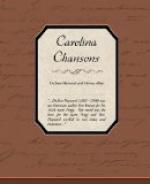Bonnet escaped, but was afterwards recaptured by Colonel Rhett on Sullivan’s Island. He and about thirty of his crew were hanged about the corner of Meeting and Water Streets. Bonnet, himself, was hanged later than his crew, after a masterpiece of invective by the judge, who painted hell vividly. This pirate leader was dragged fainting to the gallows, and there was much sympathy for him, as it was said, “His humor of going a-pirating proceeded from a disorder of the mind ... occasioned by some discomforts he found in the married state.”
NOTE ON “THE SEEWEES OF SEEWEE BAY”
The Seewee Indians, who lived on the shores of what is now known as Bull’s Bay, S.C., but was formerly called Seewee Bay, became discontented with the small prices obtained from the white traders for pelts. Seeing the ships constantly coming into the Bay from England, they conceived the idea of building large canoes and reaching England over the ocean. Several huge canoes, larger than any heretofore built by Indians, were accordingly constructed; these were loaded with the proceeds of a season’s hunting, and, manned by all the braves of the tribe, set out in the direction from which the ships came. A gale came up and the braves were never seen again. Their squaws gradually wandered off to other tribes. This event took place about 1696.
NOTE ON LA FAYETTE
TO ACCOMPANY “LA FAYETTE LANDS”
The Marquis de la Fayette, under the name of Gilbert du Motier, sailed from Bordeaux on the 26th of March, 1777, accompanied by the Baron Kalb and several French Army Officers. On the 14th of June, 1777, he first landed in America on North Island in Winyah Bay, near Georgetown, S.C., and was received at the house of Major Huger. In a letter to his wife, written soon after his landing, La Fayette says, “I first saw and judged of the life of the country at the house of a Major Huger.” Detailed accounts of La Fayette’s landing and reception still exist.
NOTE ON THEODOSIA BURR
TO ACCOMPANY “THE PRIEST AND THE PIRATE”
In 1801 Theodosia, daughter of Aaron Burr, Vice-President of the United States, married Joseph Alston of “The Oaks,” Hobcaw Barony, S.C. They had one son, Aaron Burr Alston, who died in 1812, the same year that Joseph Alston was elected Governor of the State. On December 30th, 1812, at the urgent solicitation of her father, who had just returned from Europe, and who awaited her eagerly in New York, Theodosia set sail from Georgetown, S.C., in the pilot-boat schooner, “Patriot.” Those on board were never seen again.
The vessel, which was being fitted out as a privateer, was carrying dismounted guns under her deck, and may have foundered in the severe gale of January 1st, 1813.
In 1869, however, a Dr. W.C. Pool attended a fisher family at Naggs Head, Kittyhawk, N.C. In the fisherman’s hut hung an oil painting of a beautiful woman, which had been taken from an abandoned pilot-built schooner that drifted onto the North Carolina coast in that vicinity in January, 1813. No one was aboard and the vessel had evidently been looted. Ladies’ clothes were found in great disorder in the cabin.




